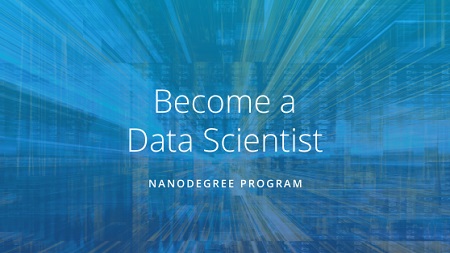
English | MP4 | AVC 1280×720 | AAC 44KHz 2ch | 43h 07m | 7.80 GB
Build effective machine learning models, run data pipelines, build recommendation systems, and deploy solutions to the cloud with industry-aligned projects.
Data science skills are in high demand, and you’ll finish this program with practical skills needed to land a data science job. You’ll build projects designed with our industry partners using real-world data, and by the end of the program you will be able to build machine learning models includng supervised and unsupervised methods; create and run data pipelines; design experiments; build recommendation systems; deploy solutions to the cloud; and more. This program is an ideal way to move into a data science career, and by the end of the program you’ll be ready to apply for data science jobs.
Term One is “Machine Learning for Data Scientists.” Across three sections, students focus on Supervised Learning, Deep Learning, and Unsupervised Learning. Featured projects include using Kaggle to build an algorithm for identifying charity donors, and creating an image classifier. Term Two is “Applied Data Science,” and the focus is on solving problems with data science, as well as software and data engineering. As a capstone project, students build their own data science portfolio project.
The Data Scientist Nanodegree program is for students who possess strong programming and data analysis skills, and is positioned as the next step for graduates of the Data Analyst Nanodegree program. Those interested in advanced analytics without programming are encouraged to consider the Business Analyst Nanodegree program, and beginners are invited to explore our Data Foundations Nanodegree program.
Table of Contents
1 Welcome to the Data Scientist Nanodegree program
2 Get Help from Peers and Mentors
3 Get Help with Your Account
4 Setting Up Your Computer
5 What Is Ahead
6 Machine Learning Bird’s Eye View
7 Linear Regression
8 Perceptron Algorithm
9 Decision Trees
10 Naive Bayes
11 Support Vector Machines
12 Ensemble Methods
13 Model Evaluation Metrics
14 Training and Tuning
15 Finding Donors Project
16 Introduction to Neural Networks
17 Implementing Gradient Descent
18 Training Neural Networks
19 Keras
20 Deep Learning with PyTorch
21 Image Classifier Project
22 Clustering
23 Hierarchical and Density Based Clustering
24 Gaussian Mixture Models and Cluster Validation
25 PCA
26 Random Projection and ICA
27 Project Identify Customer Segments
28 Congratulations!
29 Why Python Programming
30 Data Types and Operators
31 Control Flow
32 Functions
33 Scripting
34 NumPy
35 Pandas
36 Basic SQL
37 SQL Joins
38 SQL Aggregations
39 SQL Subqueries Temporary Tables
40 SQL Data Cleaning
41 [Advanced] SQL Window Functions
42 [Advanced] SQL Advanced JOINs Performance Tuning
43 Data Visualization in Data Analysis
44 Design of Visualizations
45 Univariate Exploration of Data
46 Bivariate Exploration of Data
47 Multivariate Exploration of Data
48 Explanatory Visualizations
49 Visualization Case Study
50 Shell Workshop
51 What is Version Control
52 Create A Git Repo
53 Review a Repo’s History
54 Add Commits To A Repo
55 Tagging, Branching, and Merging
56 Undoing Changes
57 Working With Remotes
58 Working On Another Developer’s Repository
59 Staying In Sync With A Remote Repository
60 Introduction
61 Vectors
62 Linear Combination
63 Linear Transformation and Matrices
64 Descriptive Statistics – Part I
65 Descriptive Statistics – Part II
66 Admissions Case Study
67 Probability
68 Binomial Distribution
69 Conditional Probability
70 Bayes Rule
71 Python Probability Practice
72 Normal Distribution Theory
73 Sampling distributions and the Central Limit Theorem
74 Confidence Intervals
75 Hypothesis Testing
76 Case Study AB tests
77 Regression
78 Multiple Linear Regression
79 Logistic Regression
80 Welcome to the Data Scientist Nanodegree Program
81 Get Help from Peers and Mentors
82 Get Help with Your Account
83 The Skills That Set You Apart
84 The Data Science Process
85 Communicating to Stakeholders
86 Project Write A Data Science Blog Post
87 Optimize Your GitHub Profile
88 Introduction to Software Engineering
89 Software Engineering Practices Pt I
90 Software Engineering Practices Pt II
91 Introduction to Object-Oriented Programming
92 Portfolio Exercise Upload a Package to PyPi
93 Web Development
94 Portfolio Exercise Deploy a Data Dashboard
95 Introduction to Data Engineering
96 ETL Pipelines
97 NLP Pipelines
98 Machine Learning Pipelines
99 Project Disaster Response Pipeline
100 Strengthen Your Online Presence Using LinkedIn
101 Intro to Experiment Design and Recommendation Engines
102 Concepts in Experiment Design
103 Statistical Considerations in Testing
104 AB Testing Case Study
105 Portfolio Exercise Starbucks
106 Introduction to Recommendation Engines
107 Matrix Factorization for Recommendations
108 Recommendation Engines
109 Data Scientist Capstone
110 Congratulations!
111 Neural Networks
112 Deep Neural Networks
113 Convolutional Neural Networks
Resolve the captcha to access the links!